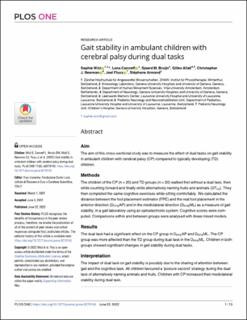Please use this identifier to cite or link to this item:
https://doi.org/10.21256/zhaw-26645| Publication type: | Article in scientific journal |
| Type of review: | Peer review (publication) |
| Title: | Gait stability in ambulant children with cerebral palsy during dual tasks |
| Authors: | Wist, Sophie Carcreff, Lena Bruijn, Sjoerd M. Allali, Gilles Newman, Christopher J. Fluss, Joel Armand, Stéphane |
| et. al: | No |
| DOI: | 10.1371/journal.pone.0270145 10.21256/zhaw-26645 |
| Published in: | PLOS ONE |
| Volume(Issue): | 17 |
| Issue: | 6 |
| Page(s): | e0270145 |
| Issue Date: | 2022 |
| Publisher / Ed. Institution: | Public Library of Science |
| ISSN: | 1932-6203 |
| Language: | English |
| Subjects: | Cross-sectional study; Gait; Human; Walking; Cerebral palsy; Gait disorder, neurologic |
| Subject (DDC): | 616.8: Neurology, diseases of nervous system |
| Abstract: | Aim: The aim of this cross-sectional study was to measure the effect of dual tasks on gait stability in ambulant children with cerebral palsy (CP) compared to typically developing (TD) children. Methods: The children of the CP (n = 20) and TD groups (n = 20) walked first without a dual task, then while counting forward and finally while alternatively naming fruits and animals (DTf/a). They then completed the same cognitive exercises while sitting comfortably. We calculated the distance between the foot placement estimator (FPE) and the real foot placement in the anterior direction (DFPEAP) and in the mediolateral direction (DFPEML) as a measure of gait stability, in a gait laboratory using an optoelectronic system. Cognitive scores were computed. Comparisons within and between groups were analysed with linear mixed models. Results: The dual task had a significant effect on the CP group in DFPEAP and DFPEML. The CP group was more affected than the TD group during dual task in the DFPEML. Children in both groups showed significant changes in gait stability during dual tasks. Interpretation: The impact of dual task on gait stability is possibly due to the sharing of attention between gait and the cognitive task. All children favoured a ‘posture second’ strategy during the dual task of alternatively naming animals and fruits. Children with CP increased their mediolateral stability during dual task. |
| URI: | https://digitalcollection.zhaw.ch/handle/11475/26645 |
| Fulltext version: | Published version |
| License (according to publishing contract): | CC BY 4.0: Attribution 4.0 International |
| Departement: | School of Health Sciences |
| Organisational Unit: | Institute of Physiotherapy (IPT) |
| Appears in collections: | Publikationen Gesundheit |
Files in This Item:
| File | Description | Size | Format | |
|---|---|---|---|---|
| 2022_Wist-etal_Gait-stability-in-ambulant-children-with-cerebral-palsy-during-dual-tasks_PlosOne.pdf | 853.49 kB | Adobe PDF |  View/Open |
Show full item record
Wist, S., Carcreff, L., Bruijn, S. M., Allali, G., Newman, C. J., Fluss, J., & Armand, S. (2022). Gait stability in ambulant children with cerebral palsy during dual tasks. Plos One, 17(6), e0270145. https://doi.org/10.1371/journal.pone.0270145
Wist, S. et al. (2022) ‘Gait stability in ambulant children with cerebral palsy during dual tasks’, PLOS ONE, 17(6), p. e0270145. Available at: https://doi.org/10.1371/journal.pone.0270145.
S. Wist et al., “Gait stability in ambulant children with cerebral palsy during dual tasks,” PLOS ONE, vol. 17, no. 6, p. e0270145, 2022, doi: 10.1371/journal.pone.0270145.
WIST, Sophie, Lena CARCREFF, Sjoerd M. BRUIJN, Gilles ALLALI, Christopher J. NEWMAN, Joel FLUSS und Stéphane ARMAND, 2022. Gait stability in ambulant children with cerebral palsy during dual tasks. PLOS ONE. 2022. Bd. 17, Nr. 6, S. e0270145. DOI 10.1371/journal.pone.0270145
Wist, Sophie, Lena Carcreff, Sjoerd M. Bruijn, Gilles Allali, Christopher J. Newman, Joel Fluss, and Stéphane Armand. 2022. “Gait Stability in Ambulant Children with Cerebral Palsy during Dual Tasks.” Plos One 17 (6): e0270145. https://doi.org/10.1371/journal.pone.0270145.
Wist, Sophie, et al. “Gait Stability in Ambulant Children with Cerebral Palsy during Dual Tasks.” Plos One, vol. 17, no. 6, 2022, p. e0270145, https://doi.org/10.1371/journal.pone.0270145.
Items in DSpace are protected by copyright, with all rights reserved, unless otherwise indicated.